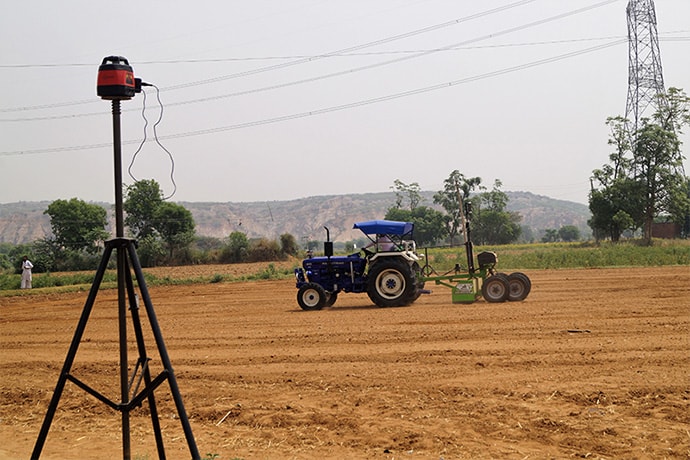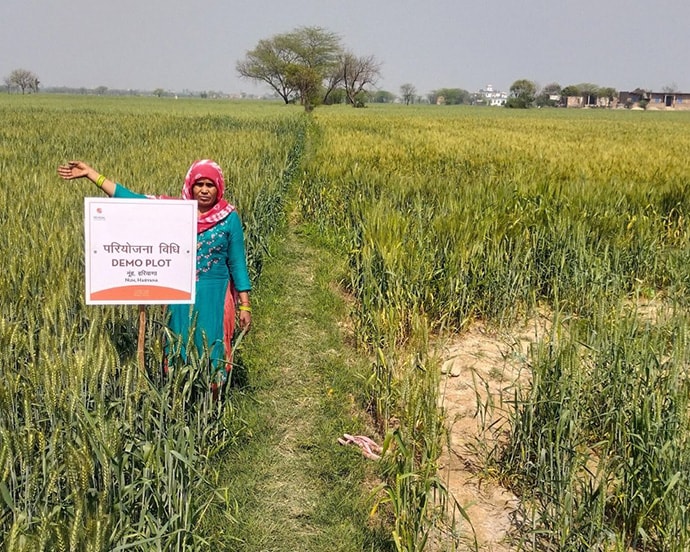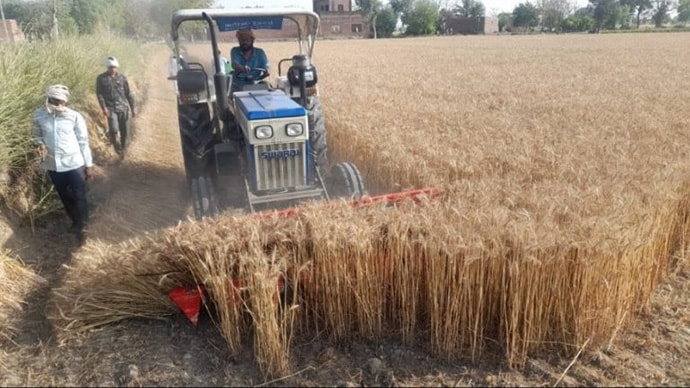“The rich get richer, and the poor get poorer”
~Percy Bysshe Shelley, A Defence of Poetry

Laser land levelling. Photo: Sehgal Foundation
This aphorism, published in 1840, may seem outdated in a twenty-first-century world driven by digitization and artificial intelligence. However, despite technological advancements, significant opportunities for growth remain. An Oxfam report on inequality in India highlights that 5 percent of Indians now own over 60 percent of the country’s wealth, while the bottom 50 percent possess only 3 percent. With 65 percent of the population residing in rural areas, a focus on rural development is crucial for balanced and inclusive progress. Efforts to address rural poverty show promising results. For instance, a study by the State Bank of India revealed a decline in rural poverty from 25.7 percent in 2011–12 to 7.2 percent in 2022–23. Despite this progress, millions remain in poverty, underscoring the need for continued focus on sustainable development.
The fight against poverty is central to Sustainable Development Goal (SDG) 1 (No Poverty). Agriculture, which employs 54.6 percent of the Indian population and contributes 17.4 percent to the GDP, is crucial for economic stability. By investing in and transforming agriculture, we can create sustainable pathways out of poverty and improve livelihoods. SDG 8 (Decent Work and Economic Growth) targets enhancing labor productivity, economic diversification, and entrepreneurial support. This goal is vital for agricultural development, farmers’ welfare, and women’s participation in agriculture, ensuring equitable access to sustainable employment opportunities.
India‘s Agricultural Development In 2023
Agriculture, supporting nearly half of the population and contributing 17% to the GDP in 2023, commands a focused approach to propel the nation’s economic development. Agriculture stands as a pivotal avenue for realizing inclusive growth. Research from the World Bank highlights the profound impact of agricultural growth on poverty reduction, notably surpassing that of manufacturing. Ensuring that this agricultural expansion maintains sustainability is paramount, while also avoiding the overexploitation of natural resources, a concern seen in regions such as Haryana, Tamil Nadu, and Punjab. Agricultural growth must embrace comprehensiveness and environmental responsibility. And ensuring women’s active involvement in agriculture is pivotal for augmenting the sector’s productivity and socioeconomic influence.
The Multidimensional Poverty Index relies on various indicators to pinpoint individuals in poverty, and one such indicator is the lack of assets. However, a poignant concern arises as women often find themselves without access to immovable property or agricultural land, even within economically comfortable households. Sixty percent of women in India depend on agriculture for their sustenance.
To monitor and realize the objectives outlined in the Sustainable Development Goals, securing comprehensive data about women’s access to land is increasingly imperative. Growth in the agriculture sector is two to four times more effective in raising incomes among the poorest compared to other sectors. Alas, such data is largely nonexistent, and this deficiency poses a considerable hurdle in pursuing numerous SDGs, particularly SDG 1 and 8, which call for sustained, inclusive, and sustainable economic growth and enhanced income opportunities. More accurate data is needed to gauge progress and effectively address women’s disparities in the agricultural sector.
S M Sehgal Foundation Encompasses the Sustainable Goals
S M Sehgal Foundation’s Agriculture Development Program champions sustainable livelihoods by empowering farmers, especially women producers, by adopting cutting-edge agricultural practices and technologies. These initiatives bolster crop yields, preserve water resources, and enhance soil fertility. The program collaborates with smallholder farmers in rain-fed and irrigated regions, focusing on various aspects, including soil health management, efficient crop production, resource utilization, mechanization, water-conserving irrigation techniques, horticultural advancements, livestock management, and the integration of information and communication technology (ICT) in agriculture.
Elevating the income of farmers is pivotal to ensuring food security in India. Agricultural intervention, driven by modern technology and mechanization, has the potential to address a multitude of challenges, including poverty, malnutrition, water and energy use, and the impacts of climate change.
Laser Land Leveling
Ayyaz, a farmer supported by a CSR project facilitated by S M Sehgal Foundation, adopted laser land leveling, reducing irrigation time and cost while optimizing crop productivity. This technique halved irrigation time and costs, significantly saving expenses and increasing yields.
Encouraging Women’s Contributions to End Poverty
Rekha, a farmer in Nuh, Haryana, struggled with low productivity, saline land and water, and no irrigation on her 1.5-acre plot. In June 2021, S M Sehgal Foundation began an integrated village development project in her village, focusing on water, education, health, sanitation, nutrition, and agriculture. The project team trained farmers in modern agricultural techniques and provided hands-on demonstrations. Rekha received a sustainable Package of Practices (PoP) kit for wheat cultivation, including micronutrients, in October 2021.

Rekha by sign in her wheat field
Under project supervision, Rekha cultivated wheat on one acre, using scientific PoP and traditional methods on an adjacent 0.5 acres for comparison. The demonstration plot showed enhanced plant length, canopy, and color. At harvest, Rekha achieved a 3.2 quintal increase in wheat yield and an extra four quintals of fodder. This improved yield resulted in an income increase of INR 11,040 from 0.5 acres, at INR 2,200 per quintal.
Goatery as Livelihood
Geeta from Mahendergarh region of Haryana, received goats in January under a CSR-supported project. She dedicatedly reared the herd, taking the required precautions and care to check mortality and predation. Her persistence led to increasing the herd size by another two bucks. Furthermore, with an average production of 2.25 liters of milk daily, she sold around 1.25 liters daily, and used the remaining 1 liter for her family. Her herd size of five units currently values around INR 32,000/-. Two of her goats are expected to deliver in July, which will further add to her total capital. The primary approach of the intervention was to reach households interested in rearing goats for the long run and gaining practical experience. This helps to increase the farmers’ income.

Geeta, with her goats, is now increasing her income and improving her livelihood. Photo: Sehgal Foundation
Multi Crop Reaper/ Harvester, A Sustainable Source Of Income
In October 2021, S M Sehgal Foundation launched a CSR development initiative in fifteen villages within Uttar Pradesh’s Mathura district. Marginal farmers primarily inhabit these villages.
The project introduces sustainable agriculture, livelihood, and entrepreneurship development solutions. To enhance agricultural income, the initiative emphasizes mechanization tailored for small-scale farming.

“In March 2022, the multi‑crop reaper was handed over to me and installed on my tractor. In the early days, some people mocked me by saying that I would not be able to recover my investment. But within five days, I got back my invested amount of INR 22,000 and, by April 12, 2022, I had harvested 58 acres of land growing wheat. I charged INR 1,400 per acre; my gross earning was INR 81,200. One of the reasons for the popularity of the multi‑crop reaper machine is that the per-acre harvesting cost is only INR 1,400 compared to INR 4,800 through manual harvesting, as well as a source of earning for the farmer entrepreneur.”
~ Ajay Kumar, recipient of a multi‑crop reaper from Undi village. Photo: Sehgal Foundation
After a needs assessment, the community identified that using combine harvesters for wheat led to the loss of valuable straw for cattle fodder and left crop residues that required burning, causing environmental pollution. The project team proposed adopting a multi-crop harvester/reaper. This versatile machine can harvest wheat, paddy, mustard, pulses, sesame, soybean, barley, oat, and fodder crops, covering ten to twelve acres per day. Compatible with various tractors, it offers a more-efficient and cost-effective alternative to manual harvesting or combine harvesters. It reduces labor, eliminates wheat straw loss, and is eco-friendly, introducing new opportunities for agricultural entrepreneurship.
Sehgal Foundation has been working towards empowering rural communities in India for the last twenty-five years. Over the years of learning and un-learning the needed approach for development, the foundation has been steady on not just creating but also sustaining the impact. Its contributions to bridging the poverty gap, and simultaneously improving on the opportunities for farmers and rural people, have been pivotal in reaching the goals of 2030. Focused on bringing people out of poverty through capacity-building and fostering their own development, the foundation has impacted 4.94 million people residing across 2561 villages in 12 states, and still going.